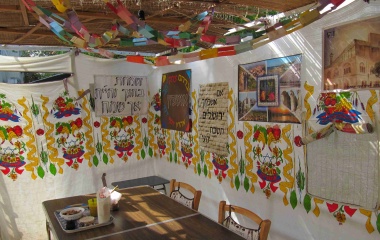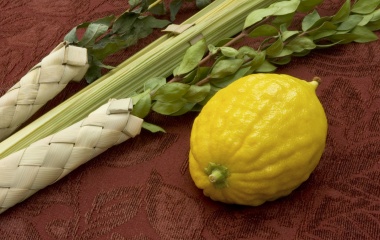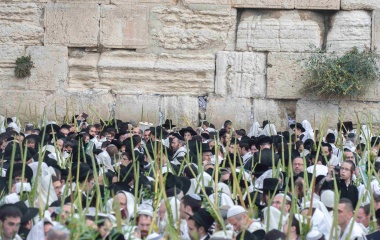
In a recent post, we discussed the opposition to the mitzvah of placing the arava on the altar. An even greater dispute arose vis a vis the mitzva of nisuch hamayim, the mitzvah to pour water on the altar in conjunction with the morning sacrifice on Sukkot.
Accompanying the daily morning sacrifice was the nisuch hayayin, the pouring of wine libations on the altar. It is wine and meat that are the symbols of joy, and it is the eating and drinking of such that are means by which we fulfil[1] the mitzvah of simcha, to rejoice. As Rav Soloveitchik noted, the mitzvah of simcha stems from being in the presence of G-d; and the Temple, as the central location of the Divine presence, is synonymous with joy. It is because we are commanded to go to the Temple on Pesach, Shavuot, and Sukkot that we are commanded vesamachta b’chagecha, to rejoice on these specific holidays. And as man rejoices with meat and wine, he is to express his gratitude through the offering of meat and wine as a sacrifice to G-d.
Sukkot is the time we mark the beginning of the rainy season and thus, b’chag nidonim al hamayim, on the festival [of Sukkot], G-d judges regarding the water. It is only natural that we would offer water libations during Sukkot[2]. Yet, while the obligation for the wine libations is spelled out in the Torah (see Bamidbar, chapter 28), the source of the water libations is shrouded in mystery. Three possibilities are presented: it is a halacha leMoshe Misinai, an oral tradition dating back to Sinai, meaning there is no source (Sukkat 34a); it is merely hinted at by the Torah, but cannot be derived from it (Taanit 2b); or it is “derived” from the extra letter yud that appears in regard to the wine libations on the sixth day of Sukkot (ibid).
Not surprisingly, the lack of a clear biblical source led many to question this practice. And often it was these groups of Jews who were in charge of the running of the Temple. The Sages instituted many practices in their dispute with those who rejected the Oral Law—often to help expose those who did not follow the rabbinic teaching[3]. We thus read in the Mishnah (Sukkah 48b) “and to the one who poured they would say, raise your hands, as one time someone poured the water on his feet (as opposed to the altar) and the entire people ‘stoned’ him with etrogim”[4].
Water plays a major theme on Sukkot, and the drawing of the water for the nisuch hamayim was done with great fanfare. Water is the crucial ingredient needed for all living things—even when the world was in a state of nothingness, tohu vabohu, “the presence of G-d hovered over the water” (Breisheet 1:2). Yet almost paradoxically, because water is so basic, it has limited status in Jewish law. It is not considered food, and one who makes a vow not to eat may still drink water. We may not use it in making an eiruv, as it does not constitute food fit for a meal. One would never offer only drinks of water to an important (or any) guest. To offer it on the altar was degrading to many. But as with the arava, G-d loves simplicity.
That one may serve G-d equally with wine or water can be seen in the teaching of the Mishnah that there were two small holes on the side of the altar, one for the pouring of the wine and one for water. The water and the wine would be poured together, yet the hole for water was much thinner that that of the wine, in order that they would reach bottom at the same time. Apparently, the rabbis wanted to demonstrate—to borrow a phrase used regarding the bringing of sacrifices in general—“whether one does much or one does little, as long as our hearts are directed towards heaven”.
[1] While the mitzvah to rejoice is manifest in eating and drinking, the actual fulfillment of this mitzvah can only be accomplished with one’s heart and the inner feeling of joy. (See On Repentance, chapter 2, where Rav Soloveitchik so beautifully explains this concept and its application to various mitzvoth).
[2] It is for this reason the korban haomer, the barley offering, is brought on Pesach, marking the beginning of the barley harvest; and the shetei halechem, the wheat offering, and the bikkurim, the fruit “offerings”, are brought on Shavuot, marking the beginning of those harvest seasons.
[3] In a similar vein, Rabban Gamliel, at the beginning of the second century, instituted v’lemalshinim, the “blessing” against informers and heretics (Hebrew-Christians) as part of the Shemoneh Esrei. Those chazzanim who refused to say this bracha—indicating, at the very least, sympathy towards these early Christians—were deemed unfit to lead prayers on behalf of the Jewish people.
[4] While such a response indicated the seriousness with which many viewed this practice, the Gemara seems to indicate that such was not a very good one. The only comment to this story is that the altar was damaged and the rabbis did some makeshift repairs just so the altar would not look so bad, but in reality, it was damaged beyond repair.



